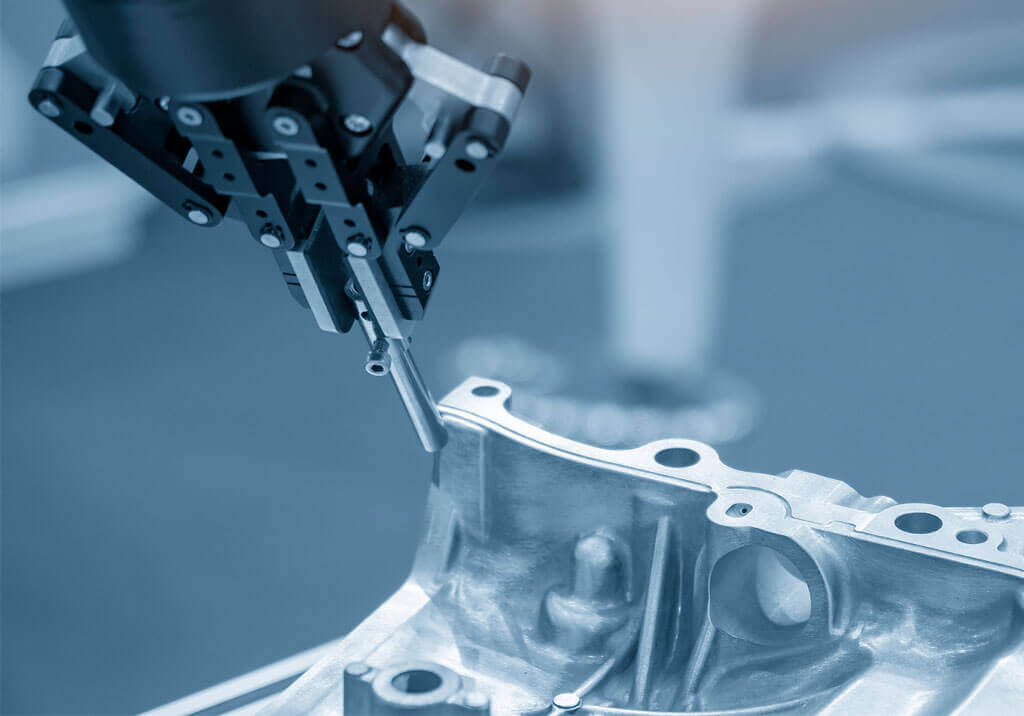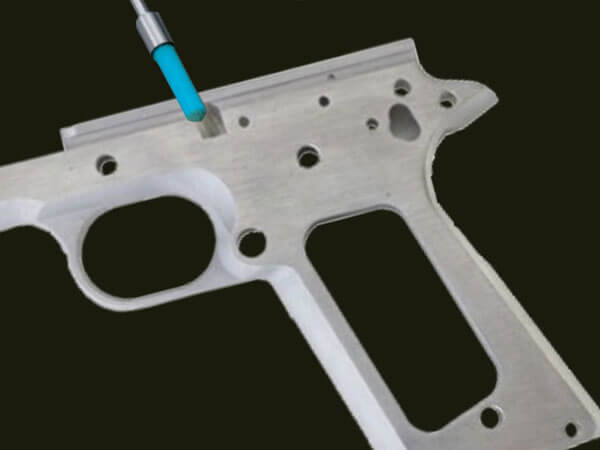According to the Global Powertrain Outlook 2021, the powertrain industry is seeing continued focus on features that are fuel-efficient, have a lower impact on the environment and promote safety, regardless of vehicle type. And though internal combustion engines (ICE) remain the most common engines in the industry, electric options are increasing in production, demand and popularity.
These priorities translate to more intense and complex expectations for manufacturers in the industry. Parts are being designed differently to accommodate today’s demands. A part’s shape, weight and finish are now even more precisely calculated to meet high standards and performance. Errors in production and finishing can lead to costly scrap and can increase cycle time, backing up your operations. For example, an employee manually finishing a camshaft might overwork the part to the point it’s no longer to spec.
Automating deburring and finishing with Xebec Deburring Technologies’ one step process is a proactive production strategy powertrain manufacturers can take to ensure consistent quality outcomes while improving productivity. These processes are some of the last steps in production for powertrain industry components. By this point, labor and production costs have added up, machine time has been spent, and insufficient quality could mean an expensive scrapped part.
Xebec’s sophisticated deburring tools eliminate production headaches by increasing consistency and helping reduce scrap and rework. This allows employees to focus on tasks other than hand deburring and finishing. An automated process is also faster and more efficient than manual methods, which opens opportunities to increase throughput and grow your business.
With Xebec products, your parts are more likely to cross the finish line – faster, more efficiently and more consistently. What could be a more perfect fit for the powertrain industry?
Xebec Deburring Solutions and Applications in the Powertrain Industry
Powertrain industry manufacturers deal with components ranging in size and complexity, primarily those related to transmissions and engines. You might serve the automotive industry, or you might produce parts for farm and construction equipment, aerospace companies, energy sectors and more.
Xebec Deburring Technologies has a variety of brushes that act like cutting tools which can be used to automate a consistent deburring and finishing process for many of these components.
Xebec Surface Brush
Oil Pan: Deburring an oil pan with a wire brush is often insufficient and leaves scratches behind. When you fully automate oil pan deburring with a Xebec ceramic fiber brush, you greatly improve surface quality and outcomes will be consistent.
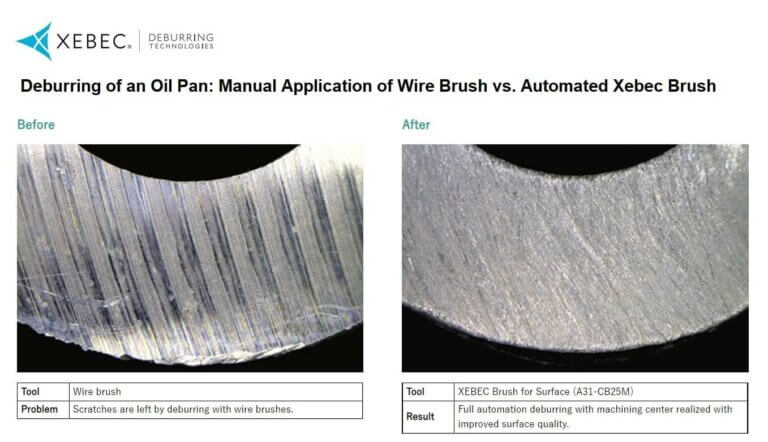

Exhaust Manifold: Filing an exhaust manifold manually takes time and leads to unstable quality. With the Xebec Surface Brush, you can automate deburring and achieve stable quality in a shorter cycle time.
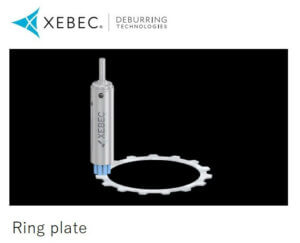
Ring Plate: In automated deburring for a ring plate, nylon brushes don’t have enough grinding power and grindstones don’t fit well to the workpieces. However, with a Xebec Surface Brush, you can realize full automation that doesn’t leave burrs on the part.
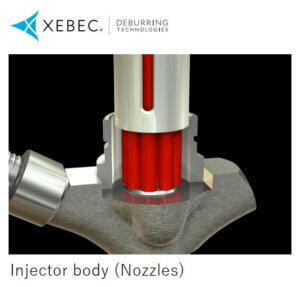
Injector Body Nozzle: For injectors, it’s critical there are absolutely no burrs on the finished part. Manual deburring typically leaves behind some burrs and requires 100% inspection. With Xebec automated deburring, random sampling instead of full inspection is achievable, resulting in decreased costs and cycle time.
Xebec Surface Brush and Xebec Floating Holder
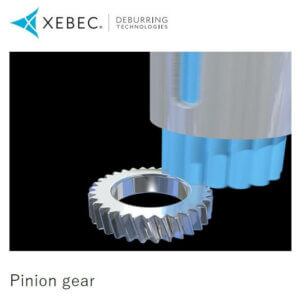
Pinion Gear: Filing pinion gears by hand takes time and doesn’t produce a stable, precise edge quality. With the Xebec Surface Brush and the Xebec Floating Holder, you can achieve automated deburring and a consistent finish in shorter time.
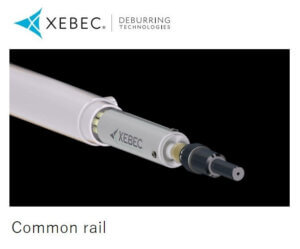
Common Rail: Deburring a common rail with sandpaper results in a low production rate due to unstable surface roughness. The Xebec Surface Brush and Xebec Floating Holder realize the required surface roughness in a shorter cycle time. In one successful application, these tools reduced labor costs corresponding to 20 hours of manual deburring work per part with sandpaper.
Xebec Back Burr Cutter and Path

Camshaft: Back deburring a camshaft with spring-type tools often results in over-deburring or incomplete deburring. Automating the process with the Xebec Back Burr Cutter and Path results in a uniform edge quality in shorter operating time.
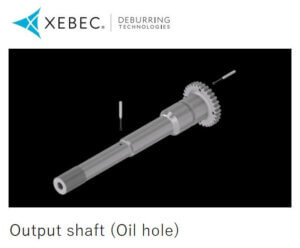
Output Shaft (Oil Hole): In one use case for deburring output shafts, a manufacturer was using cotter pin type back-deburring tools and realizing poor deburring performance, including remaining burrs, secondary burrs and uneven edges. With the Xebec Back Burr Cutter and Path, they achieved uniform results without secondary burrs.
Xebec Brush Crosshole

Transmission Case (Cross hole): Deburring the cross holes of a transmission case by hand with twisted brushes and a rotary tool is time intensive and often inconsistent dependent on the operator’s experience. Using the Xebec Brush Crosshole, manufacturers can automate this process and improve the workability and quality of the inside diameter.
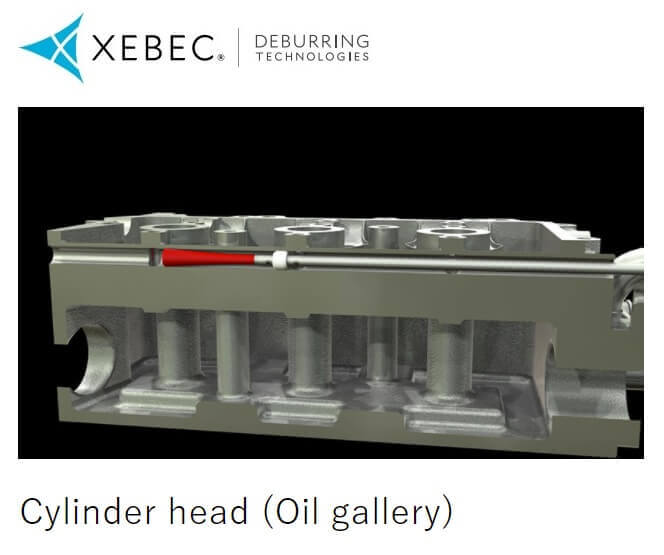
Cylinder Head (Oil Gallery): Deburring and polishing a cylinder head with an abrasive-impregnated nylon brush often fails to remove all burrs, leading to issues with quality inspection. The Xebec Extra-long Crosshole Brush stabilizes deburring and polishing quality.

Input Shaft (Cross hole): Manually deburring cross holes on an input shaft with abrasive-impregnated nylon brushes often leaves burrs behind and causes low efficiency in processing. Replace this process with automated deburring using the Xebec Brush Crosshole to remove all burrs and improve finish quality.
Xebec Stone Flexible Shaft

Carrier: Using a rotary bar and rotary tool on a carrier often leads to edge shape damage and secondary burrs. With the Xebec Stone Flexible Shaft, you can realize a stable and precise edge shape without generating secondary burrs.
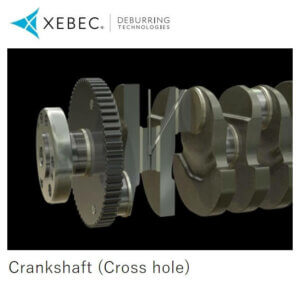
Crankshaft (Cross Hole): Manually deburring cross holes on a crankshaft with a cutter often fails to catch all burrs and can lead to a low production rate. With the Xebec Stone Flexible Shaft, you can automate deburring to achieve a stable edge quality and reduce costs.
How Manual Deburring Adds Fuel to Powertrain Industry Challenges
Powertrain industry manufacturers wrestle with many challenges in production and operations. Several of these challenges are exacerbated by outdated processes like manual deburring and finishing.
Job Costing. Estimating job cost is a perennial challenge. Bids come up too low for time and cost for several reasons. If you work backward on your costing to uncover where delays, overspending and underestimating occur, you will likely find deburring is a primary area of concern. Manufacturers often find they’ve underestimated the burr size produced or the way the metal will act in production, or they neglect to include deburring time in the estimate in general.
Consistency, Quality Issues and Scrap. Manual deburring and finishing are inconsistent and often result in scrap. And if a critical part passes QA and fails downstream, it can greatly affect your reputation, repeat business and profit margins. If you’re concerned automated deburring and finishing will add to your cycle time, consider the value of consistent quality parts, reduced scrap and reduced labor on manual processes. And if you’re dealing with a labor shortage, automated deburring provides a way to increase productivity without hiring additional labor.
Manual deburring and finishing have inherent problems that only make manufacturers’ challenges more difficult to overcome, including:
- Loss of manpower to manual processes
- Quick wear on tools used to manually sand/grind materials
- Difficulty meeting edge break requirements
- Inconsistent work and results
- Higher potential for scrap and rework
- Higher chance of injury
- More time spent on quality control inspections
- Potential need to outsource the deburring work
These issues lead to direct and indirect costs for manufacturers, such as the cost of:
- Scrapping a part
- Reworking a part
- Setting up, often multiple times per part
- Moving a part multiple times for deburring and finishing purposes
- Reduced capacity and missed production opportunities
- Potential missed deadlines and subsequent effects
- Reputational damage due to quality issues
- Worker injury related to manual processes
With an automated process using Xebec Deburring Technologies in place of manual methods, manufacturers in the powertrain industry can more readily overcome challenges – and seize emerging opportunities.
Additional successful applications include:
- Cam cap
- Connecting rod edge face
- Connecting rod machining surface
- Control box
- Cooling fin
- Cylinder head matching surface
- Flange mounting hole
- Injector body nozzle
- Injector body shoulder
- Plate
- Pulley
- Reduction gear cross hole
- Ring-shaped internal gear
- Shaft parts
- Transmission case matching surface
- VCT housing
- Yoke cylinder
- Yoke ring
Visit our website for a collection of real examples >
Cut Production Time
One manufacturing company told us they had 90 seconds of available CNC machine time to achieve the right surface finish for a part. Their machine was taking over 90 seconds to achieve a good result so they were outsourcing the finishing process. Using a Xebec cross hole brush, they were able to accomplish the deburring and finishing in one 30 second step on the CNC. This gave them the opportunity to run it longer to improve the finish. Now they run the part for 45 seconds – and they still save 45 additional seconds of valuable CNC time.
How Xebec Helps Powertrain Manufacturers Produce Consistent Quality Parts, Save Money and Improve Production
The benefits of automating deburring and finishing with Xebec Deburring Technologies are many – and they only continue to grow as manufacturers put them to work in their facilities. reduces costs and increases productivity, reduces problems downstream for your key customers.
Experience Reliable Consistency
Xebec products offer consistent results with every job, giving you the peace of mind that your parts will pass inspection and satisfy your customers. You can achieve:
- Tight tolerances
- Smooth finishes for improved sealing
- Burr removal to prevent product failure
Meet – and Exceed – Capacity
Automating deburring and finishing with Xebec technologies means you’ll complete both processes at once at a faster pace, allowing you to boost productivity at your facilities. You can lower your overall cycle times and make room in production for more jobs so you can increase your profits. You can also reallocate your manual deburring team to other valuable tasks.
Reduce Safety Risks in Production
Manual deburring and finishing present a range of safety issues, including risk of ergonomic injuries and accidents, cuts and deep wounds, injuries from debris during the process, and others. When an employee is injured, there are a lot of costs and productivity losses involved. Automating this risky work is safer, as it reduces how many times workers must move, manipulate and work with the part. An employee that knows their company values their safety is a more loyal employee who recommends their company for employment.
Realize Savings and Open Doors
A more efficient, reliable and quality process for deburring and finishing easily translates to savings and opens doors for new revenue opportunities. Xebec products are already at work helping powertrain manufacturers reduce costs related to manual labor, scrap, rework, worker injury, lost production time and more. And many of those manufacturers are finding ways to reinvest their savings and earnings into improving and growing their businesses.
Xebec Customers Experience Results
Area Tool & Manufacturing, Inc., a precision manufacturing shop, produces parts that require high precision and must-meet tight tolerances. The company wanted to optimize productivity for their two operators and six machines. Manually deburring was costing them in tools, time and labor, and they saw an opportunity to upgrade their process to better serve a high-volume customer. By automating the process with a Xebec ceramic fiber brush, Area Tool’s operators can now work other jobs while a part is deburred and polished on the machine. They’ve also improved consistency and quality, which has encouraged repeat work.Learn more by reading about Area Tool’s experience with our products.
The Value of Xebec Deburring Solutions and Expertise in the Powertrain Industry
Automated deburring and finishing with Xebec products will elevate your production processes and put your organization miles ahead compared to manual methods. Xebec ceramic fiber performs like a cutting tool, ensuring consistency and quality for that final step of your production process. It does the deburring and finishing at once, saving time on both the setup and the process itself. Plus, a Xebec tool doesn’t call off work or get sick. You can rely on these tools, re-assign employees to higher-value work and upskill them to in-demand roles, and rest assured that your parts will be of consistent quality.
At Xebec, we work with manufacturers early in designing the automated deburring and finishing process. We assist with concerns such as job costing, considering the best equipment and estimating and achieving the best production cycle times, and improving both productivity, consistency and quality. If you’re looking to start a new project, get in touch with one of our experts for insights on determining the most efficient way to deburr and finish the part.
Contact us to see how we can help you design the ideal deburring and finishing solution for your business and check out an example of our capabilities in this YouTube video.

